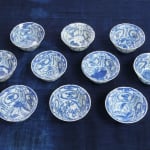


artisan's name unknown
kosometsuke small bowls (set of 10), Early 1700s
"4"" dia., 2"" (h)"
Further images
The set was made in China between the very late Ming Dynasty ( 1368–1644) and the early Qing Dynasty ( 1644–1911. )The set came to Japan in the Edo Period...
The set was made in China between the very late Ming Dynasty ( 1368–1644) and the early Qing Dynasty ( 1644–1911. )The set came to Japan in the Edo Period (1603 – 1867), perhaps in the early 1700s. Even though Japan was carrying out a closed-door policy, artworks and scholarly books from China, Holland, and Portugal came in through a tiny “man-made!” island, Dejima. A good number of Chinese ceramic works came from the island. Interestingly, only the best-selected pieces in Japanese taste came in. Observing how Japanese connoisseurs chose Chinese ceramics at that time is fascinating.
Today, Chinese collectors come to Japan to acquire ceramics that came to Japan in the Edo period because they understand it as excellent quality and taste.
The set is one of the chosen sets.
Today, Chinese collectors come to Japan to acquire ceramics that came to Japan in the Edo period because they understand it as excellent quality and taste.
The set is one of the chosen sets.
Signup for our Newsletter
You will receive two emails a month from us. One introduces artworks and design works from Kyoto's hidden sources and the other is stories from Misako, sharing insights into Japanese culture.
* denotes required fields
为了回应您的查询,我们将根据我们的隐私政策处理您提供的个人数据。


